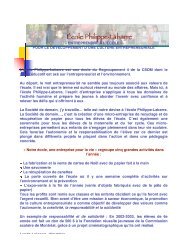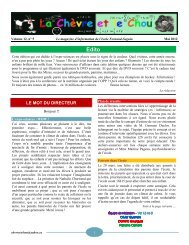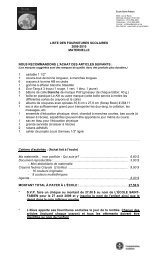Research on Child and Adolescent Mental Health
Research on Child and Adolescent Mental Health
Research on Child and Adolescent Mental Health
Create successful ePaper yourself
Turn your PDF publications into a flip-book with our unique Google optimized e-Paper software.
critical to this partnership. The insularity of<br />
disciplines that presents research barriers also<br />
affects the adopti<strong>on</strong> of research findings in<br />
practice settings; it is unlikely that treatment<br />
practices developed in <strong>on</strong>e discipline will find<br />
their way into other professi<strong>on</strong>al disciplines. The<br />
fragmentati<strong>on</strong> of systems serving children with<br />
mental health needs further complicates<br />
interdisciplinary efforts. Thus, clinical providers in<br />
primary care are unlikely to adopt mental health<br />
screening or early interventi<strong>on</strong> methods developed<br />
in child psychology or psychiatry, even though<br />
such knowledge may be critical to child mental<br />
health promoti<strong>on</strong> <strong>and</strong> early interventi<strong>on</strong> efforts.<br />
Compounding the problem of insularity is the<br />
decline over the past 10 years in the number of<br />
new investigators seeking research careers to<br />
study child <strong>and</strong> adolescent mental health. Reports<br />
from associati<strong>on</strong>s representing child <strong>and</strong><br />
adolescent physicians suggest that dwindling<br />
numbers are choosing to enter research careers.<br />
To strengthen the science base <strong>on</strong> child <strong>and</strong><br />
adolescent mental health, the research-training<br />
infrastructure must be enhanced to support a<br />
cadre of investigators who can c<strong>on</strong>duct<br />
interdisciplinary research to bridge the gaps<br />
am<strong>on</strong>g research, practice, <strong>and</strong> policy.<br />
Overcoming the Obstacles:<br />
Establishing Linkages<br />
Despite these obstacles, the prospects for gaining<br />
a deeper underst<strong>and</strong>ing of the complexities of<br />
child <strong>and</strong> adolescent mental illnesses—what<br />
causes them, what interventi<strong>on</strong>s are effective, <strong>and</strong><br />
how to get these interventi<strong>on</strong>s to those who need<br />
them— are better now than at any time in the<br />
past. This report enters the <strong>on</strong>going nati<strong>on</strong>al<br />
c<strong>on</strong>versati<strong>on</strong> <strong>and</strong> proposes the use of new models<br />
for integrating basic research with interventi<strong>on</strong><br />
development <strong>and</strong> service delivery. It also<br />
underscores the importance of using a<br />
developmental framework to guide research in<br />
child <strong>and</strong> adolescent interventi<strong>on</strong> development<br />
<strong>and</strong> deployment. Two critical acti<strong>on</strong> steps must be<br />
taken to move ahead:<br />
(1) Linkages must be made am<strong>on</strong>g<br />
neuroscience, genetics, epidemiology, behavioral<br />
science, <strong>and</strong> social sciences, <strong>and</strong> the resulting<br />
interdisciplinary knowledge must be translated<br />
into effective new interventi<strong>on</strong>s.<br />
(2) Scientifically proven interventi<strong>on</strong>s must be<br />
disseminated to the clinics, schools, <strong>and</strong> other<br />
places where children, adolescents, <strong>and</strong> their<br />
parents can easily access them. This means that<br />
the science base must be made usable. To do so<br />
will require partnerships am<strong>on</strong>g scientists,<br />
families, providers, <strong>and</strong> other stakeholders.<br />
While many of these issues have been discussed<br />
in other recent reports, am<strong>on</strong>g the most important<br />
c<strong>on</strong>tributi<strong>on</strong>s of this report are the strategies it<br />
provides to overcome the obstacles outlined above<br />
<strong>and</strong> the direct applicati<strong>on</strong> of these strategies to<br />
child <strong>and</strong> adolescent populati<strong>on</strong>s. This report<br />
suggests ways to integrate previously isolated<br />
scientific disciplines, with the goals of both<br />
creating an interdisciplinary <strong>and</strong> well-trained<br />
cadre of child <strong>and</strong> adolescent researchers <strong>and</strong><br />
strengthening the currency of mental health<br />
science. This report also provides strategies for<br />
linking basic science findings to the development<br />
of new interventi<strong>on</strong>s <strong>and</strong> ensuring that they are<br />
positi<strong>on</strong>ed within the c<strong>on</strong>text of the communities<br />
in which they will ultimately be delivered. Doing<br />
so requires the utilizati<strong>on</strong> of a new model of<br />
interventi<strong>on</strong> development, wherein factors<br />
influencing the ultimate disseminati<strong>on</strong> of the<br />
interventi<strong>on</strong> are c<strong>on</strong>sidered from the start.<br />
5

















